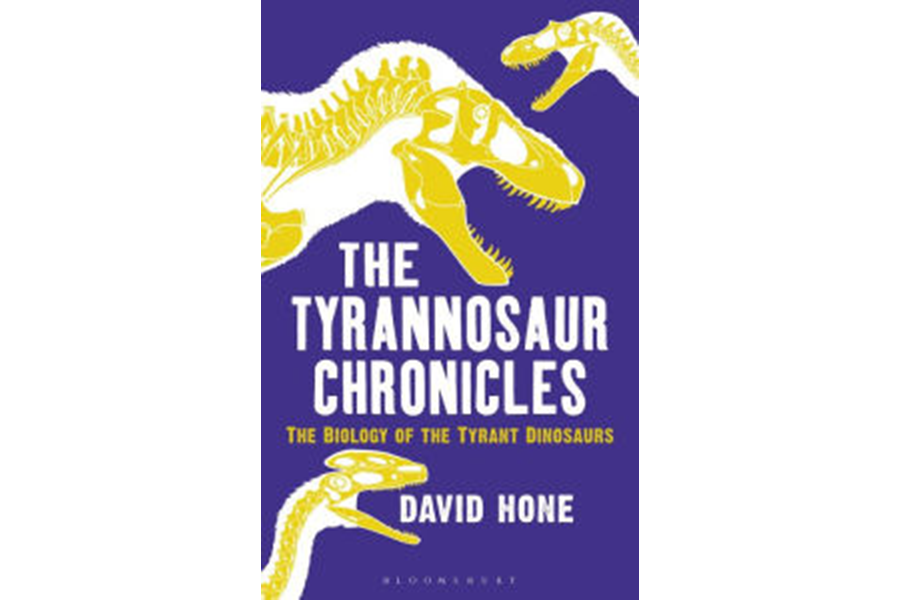'The Tyrannosaur Chronicles' tracks giant 100 million year-old lizards
Loading...
Dinosaurs ruled the surface of Earth for a mind-boggling 231 million years, and science has so far uncovered nearly 1,000 different species of every size, from every continent, in every type of ecosystem. Their fossil record expands virtually daily, and their variety extends to include herbivores the size of apartment buildings and wee things hardly larger than pigeons. And yet, despite all that staggering multiplicity and variety, when you say the word "dinosaur," only one kind of animal springs to mind: the fearsome Tyrannosaurus rex. As David Hone admits right up front in his fantastic new book The Tyrannosaur Chronicles, the tyrannosaurs were “icons of evolution, and of dinosaurs as a whole.”
Even tyrannosaurs themselves exhibited incredible variety. They were comparative latecomers to the dinosaur imperium, first appearing in the Middle Jurassic period some 160 million years ago (dinosaurs in general first appeared in the Late Triassic, 240 million years ago) in far more svelte and willowy shapes than the top-heavy, over-muscled monsters we first imagine today. They changed and spread and evolved until they finally died out around 66 million years ago. This means the tyrannosaurs were around for roughly 100 million years.
And yet, just as we first think of one kind of dinosaur when the entire group comes up, so too we only think of one kind of tyrannosaur when the whole family comes up: the Tyrannosaurus rex, 40 feet long, 20 feet tall, weighing over 10 tons, the largest land-based carnivore of all time. Every school child knows the appearance of these animals: the long, powerful tail, the gigantic legs, the comically tiny arms, and most of all the great block of a head, a battering ram of bone and scale and enormous teeth. Although the overwhelming majority of dinosaurs were placid herbivores, this is the emblem, the star – this is King Dinosaur.
Hone, a well-known dinosaur researcher based at Queen Mary University in London, is naturally aware of his subjects' star power. “Jurassic Park and King Kong would not have been the same without [them],” he writes, “and visitor numbers increase every time a museum displays a new skeleton or animatronic model.” But the chief strong point of his book is how earnestly it puts substance ahead of flash; "The Tyrannosaur Chronicles" is much more than just a celebration of the most charismatic of dinosaurs – it's also an in-depth look at what we know about them, and how we know it, although Hone warns that given the speed of dinosaur research, his book will be “out of date by the time it is published.”
Such cautions might be wise for Hone's fellow specialists, but general readers will find this book a wealth of research and detail very unlike the typical popularist look at dinosaurs – indeed, sometimes it's a bit dauntingly detailed; at one point Hone eagerly informs us that “the tyrannosaurids are diagnosed in part by having a rather short premaxilla and also heterodonty,” and there are quite a few of such passages. In these pages we get the whole story of tyrannosaurs as that story has unfolded to researchers since the first T. rex known to science was named by bone collector Barnum Brown of the Museum of Natural History in 1905.
The enthusiasm Hone brings to his subject touches on every part of the life of the “tyrant dinosaur,” including the one that's perhaps central to our imagining of the Tyrannosaurus rex: eating. The creature's head was mostly mouth, and its mouth was mostly wrench-sized serrated teeth, but even here, there can be surprises: according to Hone, findings indicate that the T. rex was a more careful eater than the popular imagination would have it. Fossilized Tyrannosaurus droppings contain smashed-up hadrosaur bones, he tells us: “The digestive tract of a large tyrannosaur might well have been a rather hostile environment – the stomach is, after all, a big, churning sack full of acid – but this evidence does suggest some degree of oral processing before the hadrosaur was swallowed.” (By “oral processing” our geeky author, rather adorably, means “chewing.”)
The book has many astonishments, but the greatest ongoing one is just how much science can know about the details of these long-vanished animals. Using an array of inquiry methods, paleontologists have mapped out an incredible number of specifics about tyrannosaurs, their behavior, their anatomy, their appearance, their evolution, and watching Hone reason through these specifics is unfailingly gripping. Whether discussing larger questions like the warm-bloodedness of dinosaurs (after hatching, tyrannosaurs grew very fast – one of many indications that they had the kind of high metabolisms that can only be supported by a warm-blooded metabolism) or even the picky details of how an animal the size of a full-grown T. rex got up in the morning (large animals can be ungainly, Hone tells us; “watching a giraffe get up in a hurry can be quite an education”), "The Tyrannosaur Chronicles" presents scientific investigation as a thrilling combination of discovery and informed guesswork. The book's subject would have ignored its prose and eaten its author, but everybody else will love it.






